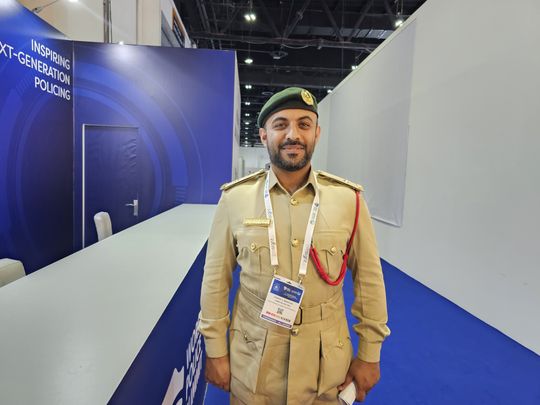
Insect database helps detectives solve ambiguity in cases involving decomposed bodies
It’s an addition to forensic medicine greatly assists investigators and the judiciary
Forensic entomology database helps raise the confidence level of investigators and remove ambiguity from a case.
Dubai: Insect evidence obtained from, in, on, or around the corpse of a victim of untimely death or homicide helps reveal the person’s exact time of death as well as other important details.
It turns that the science and practice of forensic entomology, a sub-specialisation in forensic medicine, does help remove ambiguity surrounding a case.
That’s what Dubai Police has built today. The force’s General Department of Forensic Science and Criminology has established the first insect database in the Middle East for use in forensic entomology in solving crimes.
When properly gathered, stored, and examined by a qualified and experienced forensic entomologist, insect evidence is valuable.
33 species
There are 33 known insect species that feed on corpses, explained Lt. Hussein Al Marzouqi, Assistant to Biologist Expert, Scientific and Field Supervisor of the Forensic Entomologists Team.
He told Gulf News that the team had identified the insects in over a year and a half of continuous field experiments.
In a mice study, the team made sure corpses under study were exposed to all climate conditions throughout the year and across different geographical locations in the emirate.
Currently there are eight different habitats (environment) — in each habitat there are four points, so there are 32 sites monitored by team on daily basis.
Read More
- Ramadan 2023: Watch inspirational success stories of 15 workers who became heroes in Dubai
- Rare collection of centuries-old royal manuscripts from Spain to be shown in Sharjah
- UAE: Three expats win Dh100,000 each in Big Ticket draw
- UAE ministry warns against hiring domestic workers from unverified sources
Determining time of death
At each point, there is a solar-powered thermal camera and GPS, alongside devices that measure temperature, wind speed, and humidity.
Police follow certain protocols in forensic examination. The team only works on corpses that have a criminal suspicion.
19 decomposed bodies
With the help of insect database, Dubai Police specialists have successfully determined the time of death of 19 decomposed bodies, he told Gulf News
Out of the total, 10 were normal death and others due to murder or drug overdose.
The forensic entomology database, developed in collaboration with NSF International, relies on the scientific application of insects and other arthropods in the criminal investigation.
Insects or arthropods are usually found in decomposing vertebrate corpses or carrion (decaying flesh of dead animals, including human flesh).
The database hosts information on insects’ larvae morphology (the study and description of the physical form of insects), growth histories, species distribution — as well toxic contents in their tissue and how they change according to each stage of decomposition.
Post-mortem index
Lt. Al Marzouqi said studying insect populations and larval stages enables the in-house experts to estimate the post-mortem index, any change in the position of the corpse, and even the cause of death.
“This helps investigators find leads to close cases and provide reliable and scientifically-proven evidence for court,” he said.
Study on mice
“We distributed corpses of mice in eight different habitats including mountains, shores, deserts, industrial areas and populated cities. We then put these under close monitoring, studied insects that fed on the mice over the decomposition process, made notes on how the environment variable affected the dead creatures and recorded the insects’ larvae stages,” he explains.
The team then collected information and see how insect species grow, are formed, and how they deal with different stages of decomposition of the corpse.
“This information will help us if we encounter a case in the same environment and in the same circumstances. These experiments contributed greatly to the Dubai Police forensic entomology database and enriched our knowledge on the link between policing and entomology.”
Pioneer database in the Middle East
Dubai Police have the first and only insect database in the Middle East. By early next year (2024), the project will be applied in Gulf countries and certain Arab countries.
“We will do the same experiment, counting them in order for this database to be comprehensive. Hopefully, we will reach the stage that it’s on par with European and American counterparts in this field,” he said.
Data integration
“Their teams work the way our team in the UAE works, and we will participate in data integration. The mother database is in Dubai.”
Lt Al Marzouqi added: “We work on the ground and conduct our experiments in the natural, real atmosphere. And we do these experiments to obtain highly-accurate information.”
He expects the number of species to increase. He indicated that experiments and monitoring of corpses with thermal cameras are ongoing with daily field visits and data collection.
This way, he said, “we can know, through the insect’s species and the size of the insect, the time of death and the place of death.”
“Through the insect that eats the body, we can know if there was any drug abuse or consumption of narcotic substances that contributed to the death of the person,” said Lt. Al Marzouqi.
Entomology is part of natural sciences that existed in the world for years, he said. “But it was difficult to apply it accurately in the Arab region, and we did not depend on it because there was no specialised database in our region that we could compare with,” he added.
Body found in burning car, insect revealed the cause
In one incident, the team received information from central operations room that there was a fire in a car. When the forensic entomology team moved to the site, they found a decomposed body in the vehicle which aroused suspicion.
Insects found on the body helped investigators know the cause of the death and the circumstances led to the death.
It turned out the body was that of a man who died two days earlier due to drug overdose. His friend feared legal accountability if they had reported it to police, then they burnt the vehicle to hide the crime.










